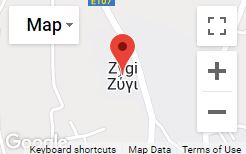The community of Zygi lies built in the south coast of Cyprus, about 40 kilometres south-east of the city of Larnaca. It is roughly in-between the three big cities, Nicosia, Limassol, and Larnaca. Zygi is the only community of Cyprus that is built on the beach and has an altitude of 8 meters.
The village receives an average annual rainfall of about 380 millimetres; mainly vegetables, legumes, forage plants, a few lemon trees, and cereals are cultivated in the area. Plant nurseries operate as well. The experimental station of the Institute of Agricultural Research also operates in the area of Zygi.
Zygi is not included in the first census that was done by the British in 1881. In the second census, done in 1891, the inhabitants of the village numbered only 15. Then -in 1901 -the inhabitants increased to 65, only to decrease to 45 in 1911 and to 33 in 1921. A great increase of the population occurred in 1931 when the inhabitants run up to 186, decreasing to 98 in 1946. In 1960 the inhabitants of the village were 171, of which 87 were Greek-Cypriots and 84 Turkish-Cypriots. After the Turkish Invasion of 1974, refugees from the north part of the island settled in Zygi. The refugees came from various regions of the occupied areas. These regions are: Flamoudi, Milia, Argaki, Rizokarpaso, Kormakitis, Davlos, Karakoumi, Agios Epiktitos, Kalograia, Karavas, Lapithos, Vavylas, Karmi, Famagusta, Arnadi, Aigialousa, Achna, Lapathos, Kalopsida, Acheritou, Egkomi, Limnia, Zodeia, Petra, Kapouti, Angastina, Vasileia, Trypimeni, Agios Sergios, Deryneia, Marathovounos, Stylloi, Nikitas, Exo Metochi, Tavrou, Kontea, Lysi, Komi Kepir, Purogi, and Kythrea. In 1981 the inhabitants of Zygi were 381. In the latest census of 2001 the inhabitants numbered 704.
Being a recently established settlement the village is not marked in old maps however -according to tradition -there was a settlement under the name of Agia Eleni (St. Helen) during the Byzantine years. The region of the village in which the river Vasilikos discharges is associated with St. Helen, mother of Constantine the Great, who -according to tradition -after her successful mission in Jerusalem where she found the Holy Cross, landed in the area of Zygi in her second visit to Cyprus.
The village -at least in its present form -started being created in the first years of the British domination, a time when the locust bean storehouses were built, the exportation of which started occurring from Zygi. The growing of locust beans was important in the surrounding area. Almost the entire locust production of Larnaca but also of Limassol was gathered in Zygi and was stored in the large stone-made storehouses. Afterwards the locust beans were milled in the locust-mills and from there -through the dock -they were loaded in ships for exportation.
The large stone-made, locust-bean storehouses that had been built then, as well as the dock for the loading on the ships, still exist today and dominate the central and coastal area of the village.
In that era the locust-beans were the main source of income of the rural population and were correctly characterised as the Black Gold of Cyprus. The decline of the locust-bean trade that followed also brought decline for the village.
The name Zygi was given to the village due to the fact that from here the locust-beans were exported and their producers brought them to be weighed (zygizo = weigh) and delivered them to the storehouses.
Only one company of locust-bean gathering and processing operates in the community today, the Co-operative Association of Locust-bean Disposal of Larnaca, which apart from locust-beans gathers and promotes the cereals and the almonds of the wider area.
Zygi has started developing in a rapid mode -during recent years -as a coastal country settlement/complex. The clear air of the sea as well as the beautiful natural environment of the region provides an outlet for the pressure and stress of the big urban centres. Several apartment complexes and cottages have been built, roads have been constructed, and the services and infrastructure projects have expanded so as to serve both the permanent inhabitants as well as the visitors of the region.
Today Zygi is the most known and reputable fisherman’s village of Cyprus. There are many professional fishermen in the village and as many amateurs. Large quantities of fish are absorbed by the seafood restaurants that operate in the community, while the surplus is channelled to the domestic market.
History – Zygi today










History – Zygi from the past


















